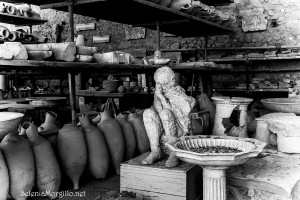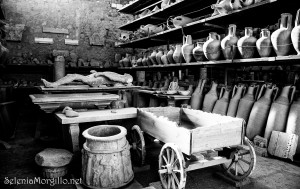Pompeii, 79 d.C.
Italian Version below*
Here is Vesuvius, once verdant with thick vineyards, once the producer, of an excellent wine: this is the mountain that Bacchus loved more than the hills of Nisa: on these cliffs, the Satyrs danced in chorus. And this was Pompeii, the favorite city of Venus, dear to her more than Sparta herself: and this was Herculaneum, dedicated to the name of the great Hercules. See, now everything is blackened, submerged by fire and ash. The gods repent of what they have done.
(Martial, Epigrams IV, 44)
Pompeii was probably founded by the Oscan populations of Campania who chose that raised place because it was naturally defended and not far from the sea, an element that favors the economic and commercial expansion of the city.
It was briefly under Etruscan rule (525 – 474 BC) and then returned to Greek orbit again. The struggle for supremacy in Campania between these two peoples was resolved by the arrival of a new people, the Samnites, who managed to seize many cities, including Pompeii itself.
Around the 4th century, BC Campania began to be crossed by Roman troops, who deducted a colony in Pompeii in 80 BC (Sillan era).
Since then the city was, in all respects, a Roman center in political and administrative life.
The scent of the destructive eruption of 79 AD was certainly the great earthquake of 62 AD.
Pompeii suffered serious damage, but the city was strong and flourishing economically and this allowed a restructuring followed by an embellishment for both public and private places.
On August 24, 79 AD, the Sum erupted. The Vesuvius of which we always speak improperly rose, after this explosion, inside the ancient crater of the Somma.
Moreover, in recent times, the hypothesis of dating oriented towards the autumn of 79 AD and not towards that August 24 always mentioned by many scholars has been increasingly confirmed.
A huge mass of ash and lapilli hit and submerged the city. The inhabitants, according to the latest estimates between 9000 and 12000, sought escape to the sea or locked themselves in their homes; in both cases, they were reached and overwhelmed by incandescent materials.
None of them understood that they lived at the foot of a volcano.
Strabo, a Greek geographer who died 50 years before the eruption, had sensed the true identity of that mountain range, as well as Diodorus Siculus, but strangely Pliny the Elder, naturalist, and commander of the Misenensis fleet, who lived on the slopes of the volcano, had not understood the danger that ran through the city.
It will be the testimony of Pliny the Elder, who will lose his life during the eruption by dying in Stabiae, handed down to us by his nephew Pliny the Younger in two missives sent to Tacitus, to be fundamental for scholars.
From that distant 79 AD, the first discovery of the city occurred by chance in the sixteenth century, on the occasion of the excavation of a canal near the Sarno river by the architect Domenico Fontana, but it was not understood that it was actually Pompeii, of which she had totally lost her memory.
Only with Charles of Bourbon in the eighteenth century (1748) did the works proceed in a more systematic way. After 1860 a new phase of studies and excavation techniques was inaugurated. He was responsible for the ingenious idea of obtaining “plaster casts” from bodies.
There have also been numerous interventions in recent years. To remember, in the summer of 2014, the opening of new 10 Domus.
To find out more: HERE
All rights reserved*
Ecco il Vesuvio, un tempo verdeggiante di folte vigne, un tempo produttore, d’un eccellente vino: questo è il monte che Bacco amò più dei colli di Nisa: su queste balze i Satiri danzarono in coro. E questa fu Pompei, città prediletta di Venere, a lei cara più della stessa Sparta: e questa fu Ercolano, dedicata al nome del grande Ercole. Vedi, ora tutto è annerito, sommerso dal fuoco e dalla cenere. Gli dèi si pentono di quello che hanno fatto.
(Marziale, Epigrammi IV, 44)
Pompei fu fondata probabilmente dalle popolazioni osche della Campania che scelsero quel luogo rialzato perché si presentava naturalmente difeso e non molto lontano dal mare, elemento che favori l’espansione economica e commerciale della città.
Fu per breve tempo sotto il dominio etrusco (525 – 474 a.C.) per ritornare poi di nuovo nell’orbita greca. La lotta per la supremazia in territorio campano tra questi due popoli, venne risolta dal sopraggiungere di un nuovo popolo, i sanniti, che riuscirono ad impadronirsi di molte città, tra cui la stessa Pompei.
Intorno al IV a.C. la Campania iniziò ad essere attraversata dalle truppe romane, che dedussero una colonia a Pompei nell’80 a.C. (epoca sillana).
Da allora la città fu, a tutti gli effetti, un centro romano nella vita politica e amministrativa.
Il sentore dell’eruzione distruttiva del 79 d.C. fu sicuramente il grande terremoto del 62 d.C.
Pompei subì gravissimi danni, ma la città era forte e fiorente economicamente e ciò permise una ristrutturazione seguita da un abbellimento sia per i luoghi pubblici che per quelli privati.
Il 24 agosto del 79 d.C., il Somma eruttò. Il Vesuvio di cui si parla sempre impropriamente si innalzò, dopo questa esplosione, all’interno dell’antico cratere del Somma.
Inoltre, negli ultimi tempi, è sempre più avvalorata l’ipotesi di una datazione orientata verso l’autunno del 79 d.C. e non verso quel 24 agosto sempre menzionato da molti studiosi.
Una massa enorme di cenere e lapilli investì e sommerse la città. Gli abitanti, secondo le ultime stime tra i 9000 e 12000, cercarono la fuga verso il mare o si rinchiusero nelle loro abitazioni; in entrambi i casi furono raggiunti e travolti dai materiali incandescenti.
Nessuno di loro aveva capito di vivere ai piedi di un Vulcano.
Strabone, geografo greco morto 50 anni prima dell’eruzione, aveva intuito la vera identità di quel rilievo montuoso, così come Diodoro Siculo, ma stranamente Plinio Il Vecchio, naturalista e comandante della flotta misenensis, che viveva alle pendici del vulcano, non aveva capito il pericolo che correva la città.
Sarà proprio la testimonianza di Plinio il Vecchio, che perderà la vita durante l’eruzione morendo a Stabiae, tramandataci dal nipote Plinio il Giovane in due missive inviate a Tacito, ad essere fondamentale per gli studiosi.
Da quel lontano 79 d.C. il primo ritrovamento della città avvenne per caso nel XVI secolo, in occasione dello scavo di un canale nei pressi del fiume Sarno ad opera dell’architetto Domenico Fontana, ma non si capì che si trattava effettivamente di Pompei, di cui si era persa totalmente la memoria.
Soltanto con Carlo di Borbone nel XVIII secolo (1748), i lavori procedettero in maniera più sistematica. Dopo il 1860 una nuova fase di studi e di tecniche di scavo fu inaugurata. A lui si deve l’ingegnosa idea di ricavare “i calchi di gesso” dai corpi.
Numerosi sono stati gli interventi anche negli ultimi anni. Da ricordare, nell’ estate del 2014 , l’apertura di nuove 10 Domus.
Per saperne di più: QUI
Sostieni #laculturachevince, aiuta la condivisione.

